Wyoming has two national parks, several national monuments and recreation areas with rivers, lakes, rugged peaks, fantastic rock formations and ecosystems that make this state a natural wonderland. In Wyoming, national parks, national monuments and recreation areas are similar areas of natural beauty, with only slight differences.
A national park is a protected area designated to preserve the natural environment, while a national monument contains things of historical, cultural or scientific significance. What differentiates a national recreational area from the other two is the protection offered to preserve recreational activities in areas with numerous natural and aesthetic features.
If you want to get outdoors and explore the best national recreation areas, national monuments or national parks in Wyoming, here’s everything you need to know.
Contents
Wyoming National Parks And Monuments
1- Yellowstone National Park
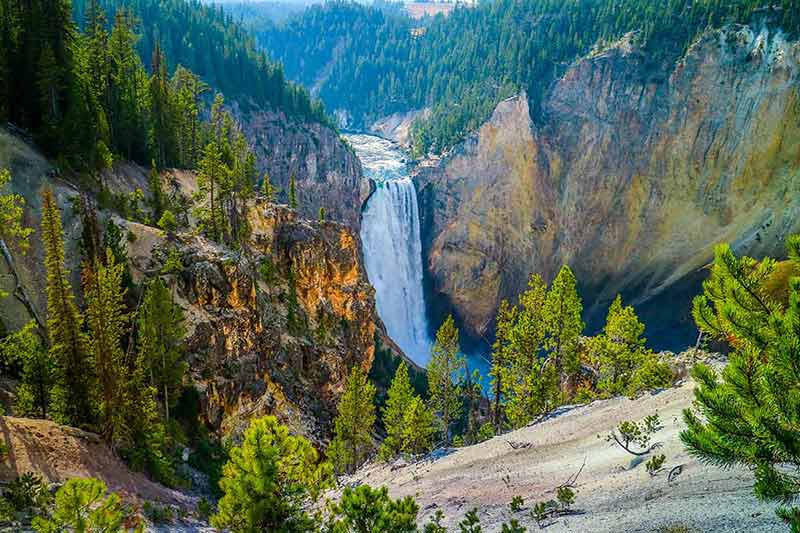
Yellowstone National Park is mainly in Wyoming, with portions of it extending into Idaho and Montana.
Spread across 2,219,789 acres (3,500 square km), this park is one of the largest national park in the USA.
It is well-known for its unique geology, diverse wildlife and natural features.
The national park status was established by the United States Congress in 1872 and signed into law by President Ulysses S. Grant, making it the first national park in the country.
Since then, millions of tourists have visited the park to enjoy its hiking trails, scenic views, and attractions.
Yellowstone National Park has a unique volcanic terrain and more hydrothermal features – including fumaroles, hot springs and geysers – than any other park on the earth.
This is mainly because there’s an active supervolcano beneath the park. However, given the previous eruption occurred around 640,000 years ago, there is little chance of an eruption occurring anytime soon.
In addition to its distinctive geological features, Yellowstone National Park has a wide range of animal and plant species.
It is home to over 1,500 types of trees and other vascular plants.
Conifers, such as subalpine fir, Engelmann spruce, rocky mountain douglas-fir, and whitebark pine and lodgepole pine, can be found in scattered groves throughout the park.
Deciduous trees such as quaking aspen and willows are also common.
Large mammals in the park include elk, moose, mule deer, white-tailed deer, mountain goat, pronghorn and bighorn sheep.
This is also the location of the largest bison herd in the United States.
Large predators such as wolves, black and grizzly bears, cougars, mountain lions, birds, fish and reptile species can also be found here.
Things To Do
Visit Grand Prismatic Spring
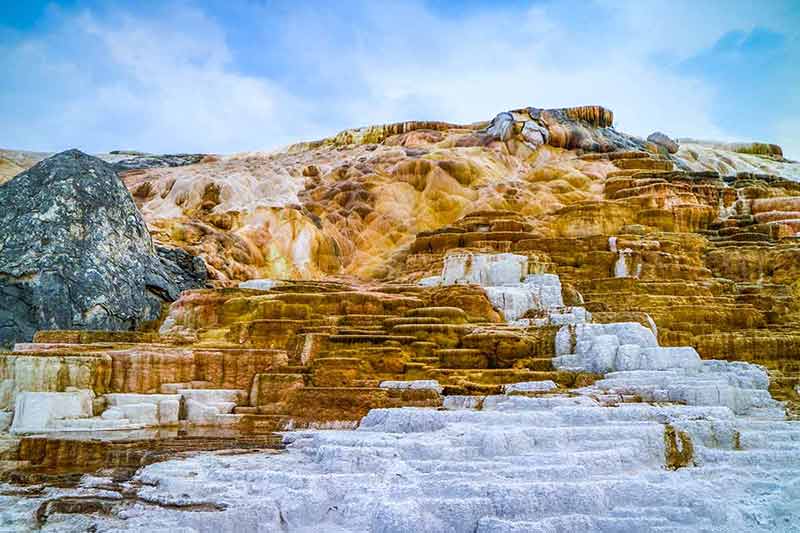
Grand Prismatic Spring is the largest hot spring in the United States and the third-largest in the world.
Bands of yellow, orange, and green form progressively coloured rings around the blue spring water.
Thermophile (heat-loving) bacteria that live in the water cause the hues while the centre is blue because water reflects the blue wavelengths of light.
Watch a Geyser Erupt
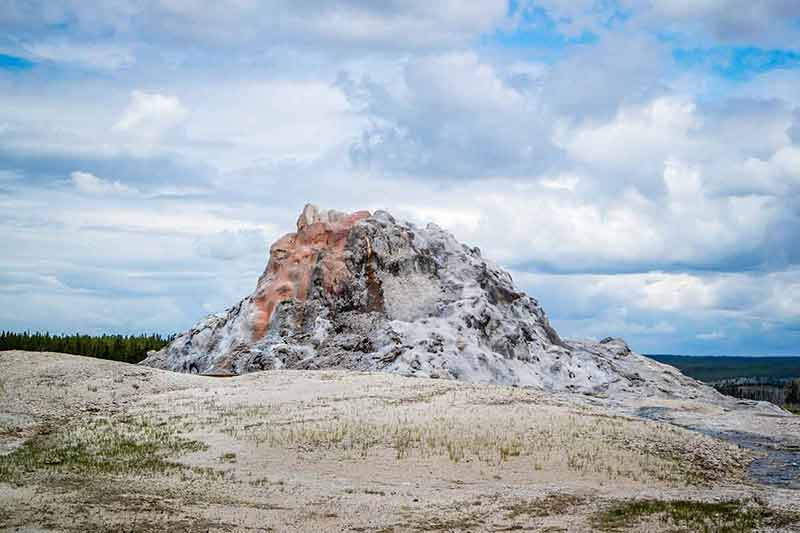
Old Faithful Geyser is one of Wyoming’s most famous natural features and is popular because of its fairly predictable eruption schedule roughly 90 minutes apart.
Other popular geysers that can be seen in action here include White Dome Geyser, Castle Geyser and Riverside Geyser.
Admire the Wildlife at Lamar Valley
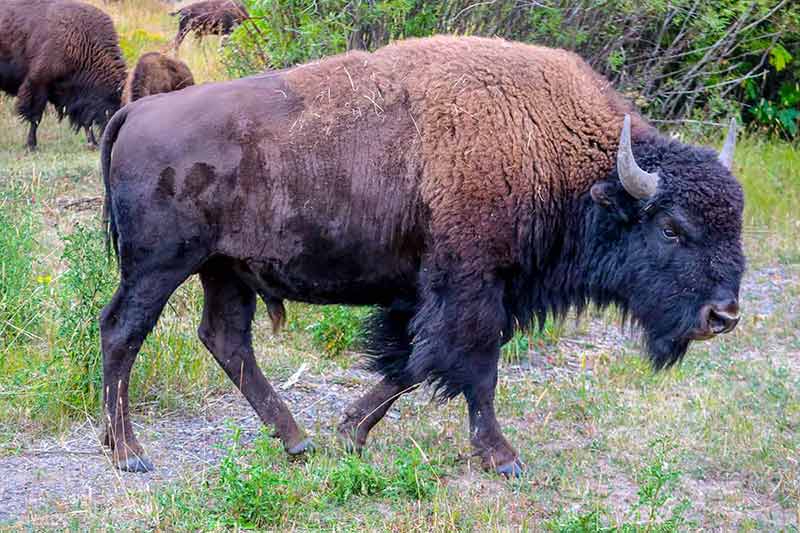
Watching wildlife in Lamar Valley is one of the attractions for nature lovers and hundreds of bison roam this valley.
Other species such as elk, coyote, deer, wolves and bears also roam the vast plains.
Experience the Grand Canyon of the Yellowstone
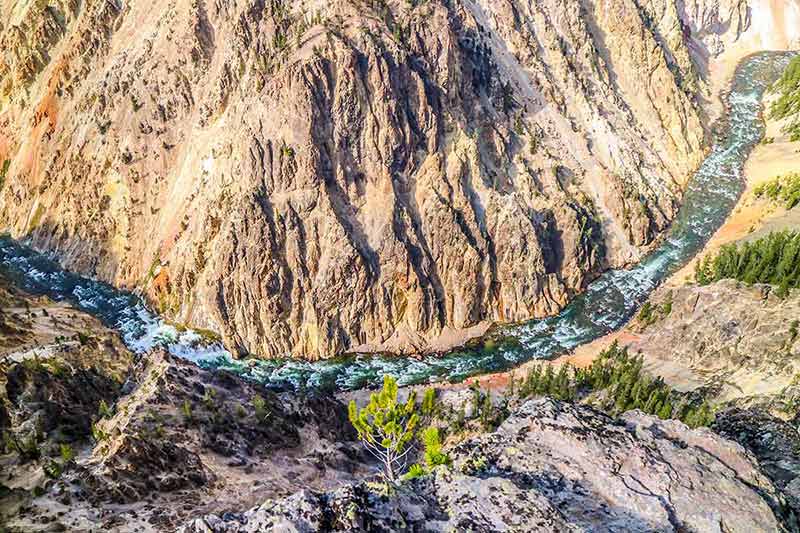
Yellowstone National Park’s Grand Canyon is a stunning natural feature of the park.
It may not be as spectacular as the famous Grand Canyon in Arizona but it’s still a spectacular natural wonder.
Highlights are the Lower and Upper Falls.
Lower Falls drops 308 feet (94 m) down the canyon, and Upper Falls, which drops 109 feet (33 m), can be seen from various vantage points around the canyon.
How To Get To Yellowstone National Park
The closest airport is Yellowstone Regional Airport in Cody, around 50 miles (80 km) away.
Fly into Jackson Hole Airport in Jackson, Gallatin Field Airport in Bozeman, Montana, or Idaho Falls Regional Airport both 65 miles (105 km) away.
Another option is flying to Salt Lake City Airport, over 400 miles (644 km) away, and renting a car from the airport.
2- Grand Teton National Park
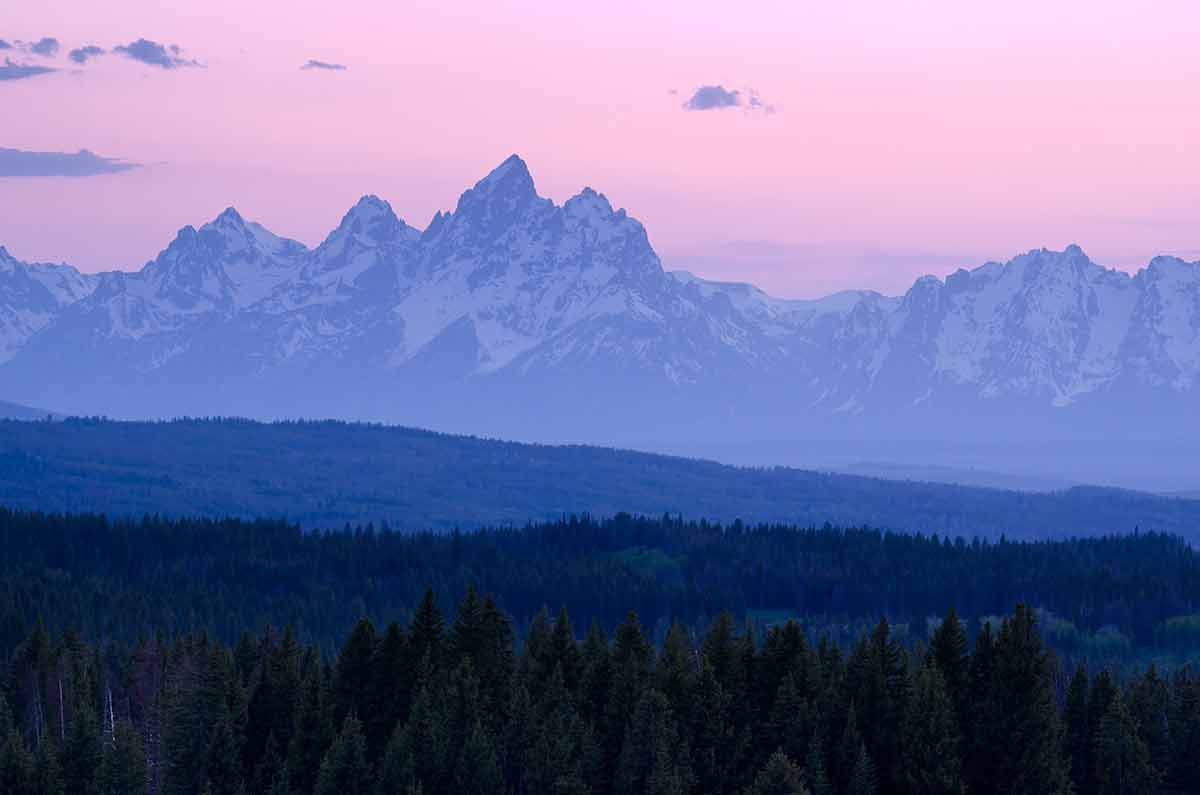
In northern Wyoming, Grand Teton National Park is a stunning 310,000-acre (125,000 ha) glaciated mountain range.
It lies 10 miles (16 km) south of Yellowstone National Park and north of Jackson, with the National Elk Refuge adjacent to its southeastern boundary.
In 1929, the Grand Teton mountain range area became a national park to protect the peaks in the range.
The park was named after Grand Teton, the highest peak in the Teton Range, which stands at 13,775 ft (4,199 m), and more than 7,000 ft (2,100 m) above Jackson Hole Valley.
This park has a diversified ecosystem with a vast range of flora and fauna, some of which have existed since prehistoric times.
There are over 1,000 species of vascular plants, including red gilia, silvery lupine, low larkspur, and shrubs like antelope bitterbrush, low sagebrush and rabbitbrush.
Common conifers include lodgepole pine, limber pine, whitebark pine and blue spruce.
The park also offers wildlife viewing opportunities, as it is home to various mammals and birds, a few reptile and amphibian species, and dozens of fish species.
Both black and grizzly bears, grey wolves, coyotes, bison, bald eagles, pronghorn, elk and ground squirrels can be found here.
Things To Do
Drive Signal Mountain Road
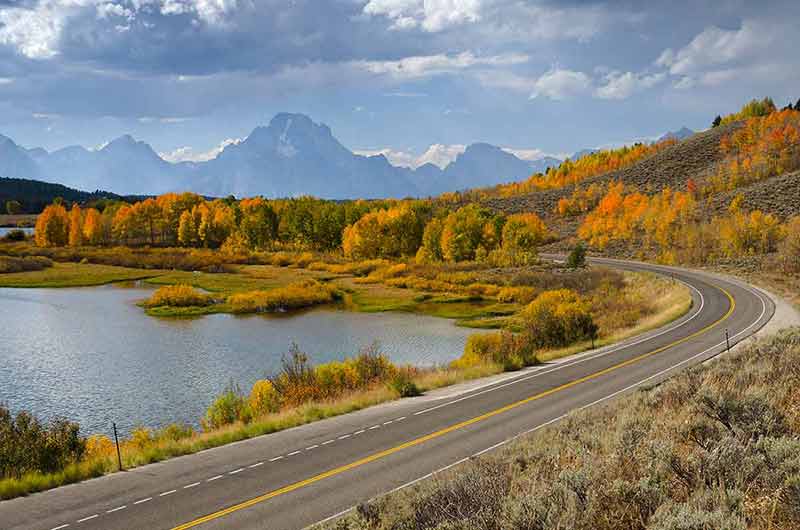
Drive along the five-mile (8km) road that twists and turns its way to the peak of Signal Mountain to admire stunning peaks, vast valley floors and lush forests.
Drive Teton Park Road
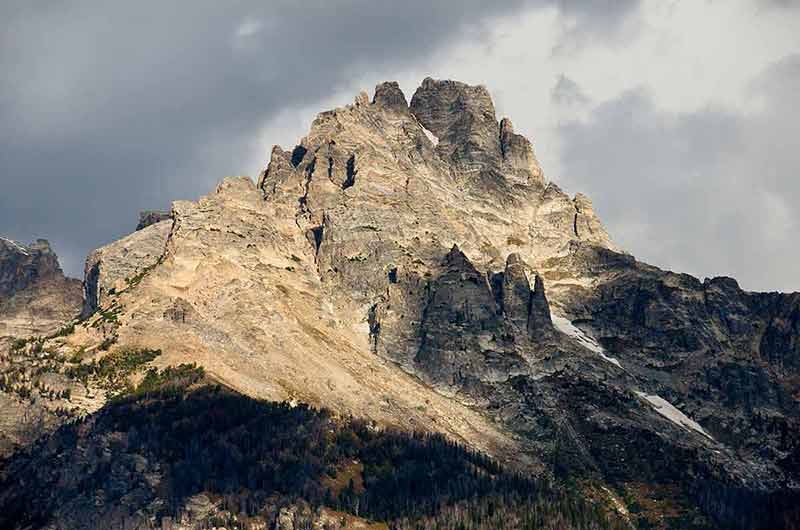
Teton Park Road winds around the base of the Teton Range, offering spectacular views of the Tetons, Snake River, Menor’s Ferry Historic District and Jenny Lake. Keep an eye out for elk, moose, bison and bears.
Visit Craig Thomas Discovery & Visitor Center
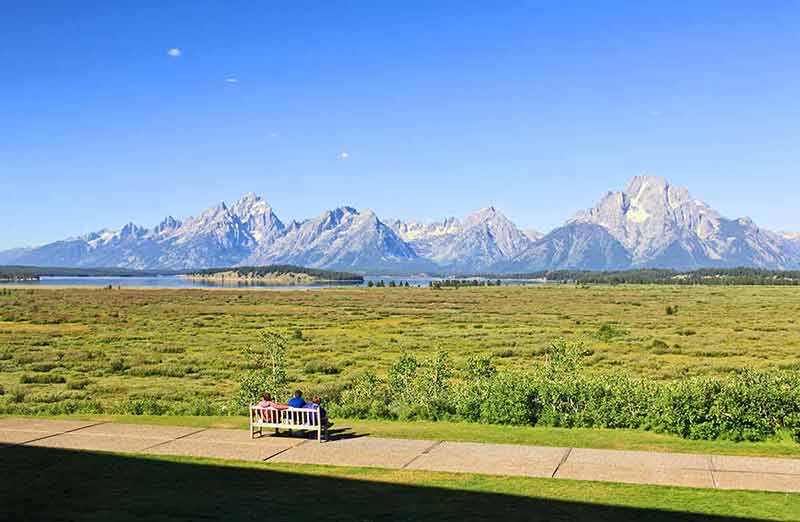
The impressive facility showcases the majestic Teton Mountains and has detailed maps, Native American artifacts, information about hiking trails, ranger programs and displays on the park’s history. There is also an in-house theatre where a documentary on the park is shown.
Take A Hike To Taggart Lake
Taggart Lake is a beautiful lake with a backdrop of trees and towering peaks.
The hike leading to the lake is a moderately difficult one that begins at the foot of the Teton Range.
Expect to be met with pleasant views of the lake, nearby flowing streams, flower-filled meadows, and pristine woodlands.
How To Get There
Jackson Hole Airport is the nearest airport to this park, with commercial and charter flights options as well as rental cars, taxis and shuttles. Jackson is the closest city to the park, about a 30-minute drive away.
Salt Lake City’s International Airport is a hub for all major airlines, with flights arriving from across the United States and worldwide.
3- Bighorn Canyon National Recreation Area
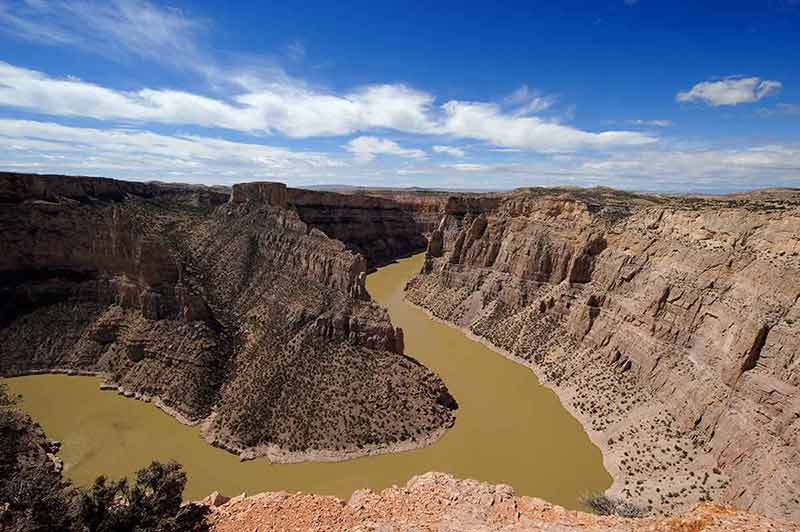
Bighorn Canyon National Recreation Area is on the border of northern Wyoming and southern Montana.
It’s a vast and varied landscape with over 120,000 acres (48,500 ha) to explore.
Bighorn is well-known for its magnificent beauty, a diverse range of habitats and abundant recreational opportunities.
This recreation area was established in 1966, after the construction of the Yellowtail Dam by the Bureau of Reclamation.
The Robert Yellowtail Dam, named after the renowned Crow leader, captures the waters of the Bighorn River and transforms it into a magnificent lake.
In normal conditions, Bighorn Lake stretches for around 71 miles (114 km) through Wyoming and Montana, with 55 miles (89 km) of it confined within the canyon.
Since its establishment, the recreational area has provided tourists with a tranquil and beautiful atmosphere in a way that few other national parks have.
The park’s vegetation consists mainly of desert shrubland, juniper woodland, mountain mahogany forest, sagebrush prairie, basin grassland, and coniferous woodland.
The wildlife is diverse and includes bighorn sheep, wild horses, coyotes, mule deer, snakes, mountain lions, bears and hundreds of bird species.
Things To Do
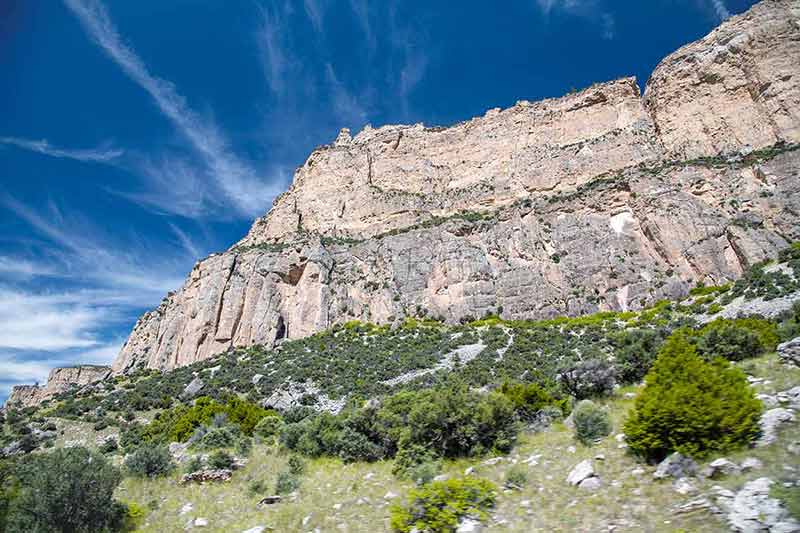
Camping
This recreation area has several campgrounds with over 100 campsites, most surrounded by some of the most breathtaking scenery in western USA.
Trout Fishing
Afterbay Lake, located beneath Yellowtail Dam, is a popular spot for trout fishing and viewing ducks and geese while the Bighorn River below Afterbay Dam is also an excellent trout fishing location.
Visit Ranch Sites
There are four historic ranches within the recreation area that have been preserved in their original state where you can learn ranching skills and discover the history of the ranch sites.
Horseback Riding
Horseback riding is available in the South District of the park and offers an authentic western adventure.
Hiking
Bighorn Canyon National Recreation Area has over 27 miles (43 km) of trails, ranging from short walks to longer hikes that present stunning views of nature.
How To Get There
This park is separated into two districts: North and South Districts.
Fly into Logan International Airport in Billings, Montana, to access either section or Yellowstone Regional Airport in Cody for the South District.
Private planes can land at the 5U7, an unattended airstrip in Fort Smith, Montana.
There is no public transportation in the park, but you can rent a car in the nearby city of Billings.
4- Devils Tower National Monument
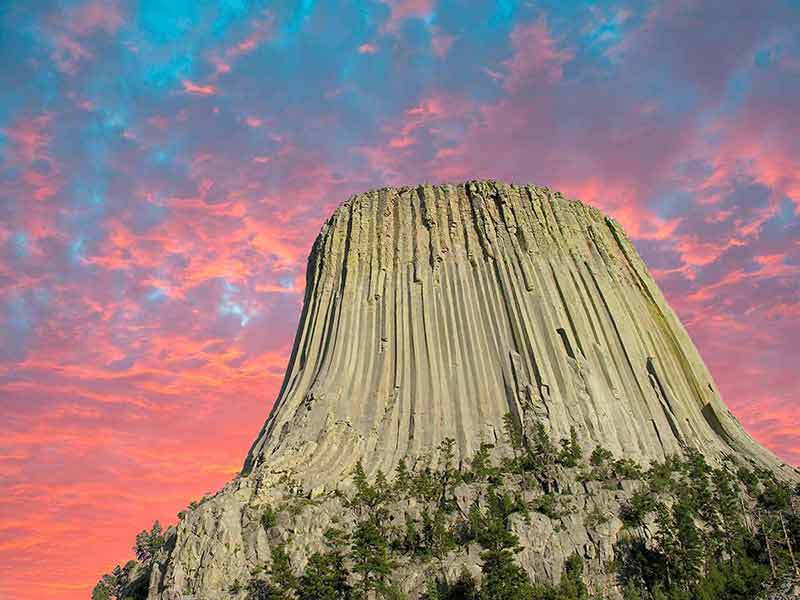
The Devils Tower National Monument in northeastern Wyoming was established to preserve the 264m (867 ft) butte known as the Devils Tower.
This remarkable geological formation is made of an igneous rock called phonolite porphyry and rises 5,112 ft (1,558 km) above sea level.
Despite being formed by magma, the tower was never a part of a volcano and according to geologists, Devil’s Tower is an igneous intrusion — a place where magma from the earth’s mantle pushes its way through sedimentary rock fragments.
The tower is light grey and buff, with lichens covering parts of it and sage, moss and grass growing on top.
This Wyoming national monument was the first national monument in America, dating back thousands of years.
It’s a sacred site for Northern Plains Indian tribes such as the Lakota, Cheyenne and Kiowa.
These tribes continue to hold sacred ceremonies at this tower in June and climbing the monument is a controversial topic.
Tribe leaders consider climbing the monument a desecration of a sacred place but some people continue to climb during the ceremonial periods because they believe they have the right to, while others refrain from doing so out of respect for the religious traditions of the tribes.
The surrounding terrain is covered in a pine forest that is home to wildlife like pronghorns, white-tailed deer, mule deer, bison, prairie dogs, and bighorn sheep.
Mountain lions, foxes, bobcats and coyotes are also present, though rarely seen. Bald eagles, hawks, falcons, vultures, lizards and snakes can also be found here.
Things To Do
Rock Climbing
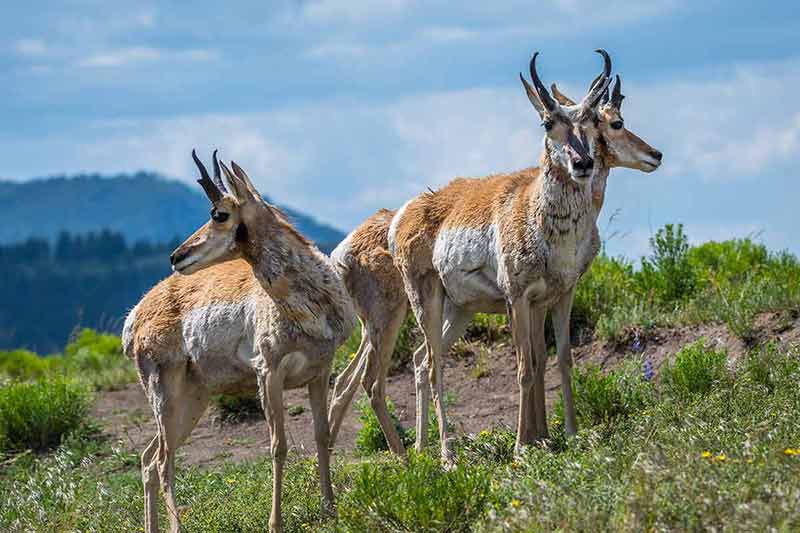
Hundreds of parallel cracks divide Devils Tower into hexagonal columns, making it one of the top rock climbing locations in North America.
There are many regular and recorded climbing routes on each side of the tower, ranging from intermediate to difficult.
The Durrance and Wiessner routes are the oldest and most popular among modern climbers.
Hiking
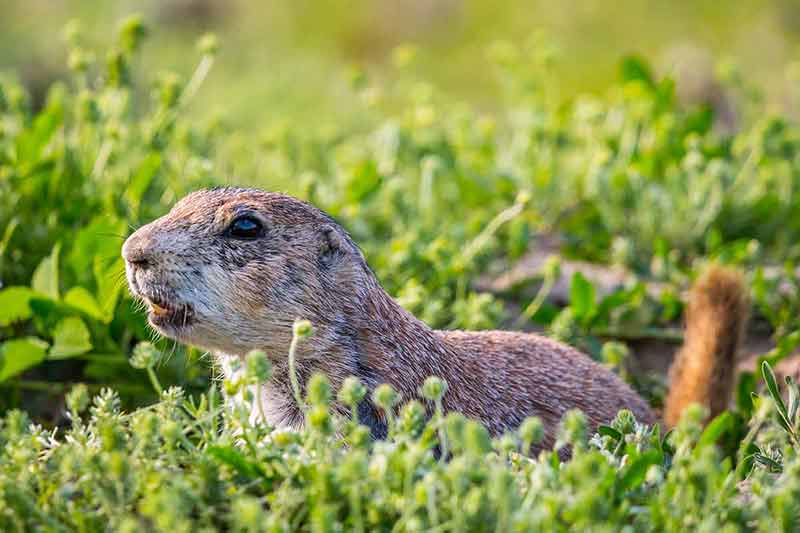
This national monument in Wyoming contains several hiking paths that offer spectacular views of Devils Tower and the surrounding landscape.
The shortest trail is the Amphitheater Circuit, which is 1.5 miles (2.4 km) and goes up in a steep slope on the south side of the tower.
Three other popular trails to spend the day exploring are the South Side Trail, Red Beds Trail and Joyner Ridge Trail.
Circle of Sacred Smoke Sculpture
Artist Junkyu Muto created the sacred smoke sculpture to pay homage to the American people as a gesture of world peace.
This artwork is meant to raise awareness of the importance of the Devils Tower to over 20 native tribes.
The sculpture is part of a collection of seven and depicts the first puff of smoke from a freshly lit pipe.
How To Get To There
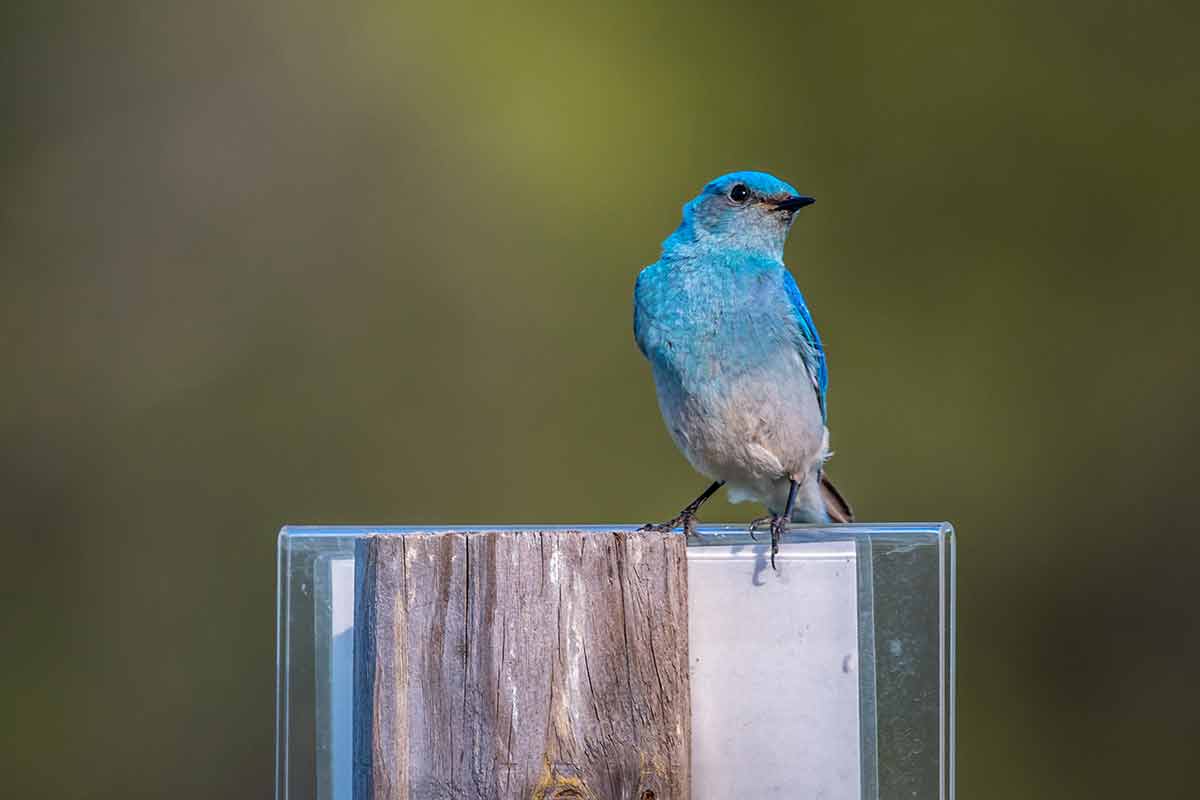
You can reach the Devils Tower via Interstate 90, taking US Highway 14 from Moorcroft, WY, or US Highway 14 from Sundance, WY.
Wyoming Highway 24 connects with US Highway 14 6 miles (10 km) south of Devils Tower Junction.
The Tower is also accessible from the north through Wyoming Highways 24 and 112, after passing through Hulett, the closest city to the site.
5- Fossil Butte National Monument
Fossil Butte National Monument is an 8320-acre (3366 ha) fossil-rich area in southwestern Wyoming.
Established in 1972, Fossil Butte is a flat-topped sedimentary rock structure formed by a small portion of what was formerly Fossil Lake.
This Eocene geologic deposit, which has full paleoecosystems preserved in limestone, offers a glimpse into ancient history from the early Eocene epoch, which happened more than 50 million years ago.
Unlike few other known fossil sites, this site demonstrates the interdependence of plants, insects, fish, reptiles and mammals.
Incredibly, the Green River Formation, the uppermost stratum of the rock, contains fossils of more than 20 freshwater fish, the most extensive record of fossilised freshwater fish in North America.
Fossils of turtles, bats, birds, mammals, snakes, crocodiles and various plants have also been discovered here.
Other formations, such as the Wasatch Formation, have also produced fossils of early primates, turtles, alligators, lizards and remains of archaic horses no larger than domestic cats.
Lower elevations are dominated by sagebrush and grasses, while the slopes are dominated by aspen and limber pine.
Elk, mule deer, pronghorn, beaver and various birds can be seen in the area.
Things To See and Do
Fossil Butte National Monument Visitor Center
This Visitor Center is where to see interactive exhibits, multimedia displays and more than 80 fossils.
A short film describing the site, the fossils discovered there and what scientists have learned is also shown to visitors.
Ranger Programs
During the summer, the monument offers a variety of ranger programs that teach visitors about the fossils, the geology of Fossil Butte, tools used by paleontologists and how to prepare a fossil.
The Quarry Program allows visitors to search for fossils.
Enjoy the Scenic Drive
The Scenic Drive starts outside the visitor centre parking lot and continues for 2.5 miles (4 km) to the Nature Trail parking area.
It ends on the top of a ridge that offers breathtaking views of the valley below.
How To Get There
Travel 9 miles (14 km) west of Kemmerer, WY on US Highway 30. Near milepost 44, look for a highway sign and turn right onto Lincoln County Road 300. You can find the Historic Quarry Trail about a half-mile to the right.
Continue west on County Road 300 for approximately 1.5 miles (2.4 km) to Chicken Creek Road, which leads to the visitor centre, Scenic Drive, Nature Trail and picnic area.
There is no public transportation to the park. The nearest airports are 130 miles (209 km) away in Rock Springs, WY, and 150 miles (241 km) away in Salt Lake City, UT.
6- Fort Laramie National Historic Site
Fort Laramie was an important 19th-century trading station, diplomatic location, and military outpost at the confluence of the North Platte and Laramie rivers.
This 536 acre (216 ha) national historic site protects and interprets one of America’s most important places in western expansion and Indian opposition history.
It played a significant role in major events when the struggle between two cultures for dominance of the northern plains escalated into conflict.
It all began in 1834 with the establishment of a private fur trading post to facilitate fur trade in the region.
The military purchased Fort Laramie in 1849 and organised it as a military garrison.
The fort grew to become the largest and best-known military outpost on the Northern Plains, playing a key role in the history of the frontier.
During the “Great Sioux War” in 1876, Fort Laramie served as a base for military operations before being abandoned in 1890.
Things To Do
Take a Tour of Fort Laramie
Starting at the visitor centre, you can learn about the location and the history of Fort Laramie by watching an 18-minute orientation film and participating in a unique audio tour program.
The facility now includes 22 original structures that have been restored and are open to the public.
Visit the Army Iron Bridge
The Army Iron Bridge serves as the starting point for the 1.6-mile (2.5-km) Confluence Trail, which leads to the confluence of the North Platte and Laramie Rivers.
The site provides excellent vistas, and visitors can see various birds and other wildlife species along the rivers.
Stop at Fort Laramie Frontier Trading Post
This is a truly unique store in the town of Fort Laramie and although this store is not part of the National Historic Site, it is well worth visiting.
You can buy items and souvenirs depicting the history of the site, such as fur, bone-handle knives, spears, civil war clothing and Indian artifacts.
How To Get There
The closest town is Fort Laramie, named after the historic site and is located around 3 miles (5 km) east of it. Torrington is also about 23 miles (37 km) away from the site and is within driving distance.
- 40 Things To Do In Lake Tahoe
- 15 Things To Do In Salt Lake City
- 21 Things To Do In Lubbock
- 20 Things To Do In Fremont
- 20 Things To Do In Manhattan Beach
- 20 Things To Do In Malibu
- 20 Things To Do In Santa Ana
- 20 Things To Do In Long Beach
- 20 Things To Do In The Hamptons
- 20 Things To Do In Berkeley
- 20 Things To Do In Tombstone AZ
- 20 Things To Do In Idaho Springs
- 20 Things To Do In Fredericksburg, VA
- 20 Things To Do In Eureka
- 20 Things To Do In Santa Rosa
- 20 Things To Do In Stamford
- 20 Things To Do In Columbia MO
- 20 Things To Do In Roswell NM
- 20 Things To Do In Ventura
- 20 Things To Do In Yuma AZ
- 25 Unusual Things To Do In New York City
- 11 Things To Do In San Francisco For Couples
- 10 Things To Do In Seattle
- 10 Things To Do In San Jose
- 20 Things To Do In Redding
- 20 Things To Do In Bakersfield
- 20 Things To Do In Monterey
- 20 Things To Do In Riverside
- 20 Things To Do In Fresno
- 20 Things To Do In Anaheim
- 20 Things To Do In Breckenridge
- 20 Things To Do In Fort Myers
- 20 Things To Do In Ruskin
- 20 Things To Do In Provo
- 20 Things To Do In Hartford CT
- 20 Things To Do In Newark
- 20 Things To Do In Princeton NJ
- 20 Things To Do In Vancouver WA
- 20 Things To Do In Beverly Hills
- 20 Things To Do In Santa Cruz
Plan Your Trip

Rent A Car – Find the best car rental rates at Discover Cars. They compare car hire companies to provide you with the best deal right now.

Find A Hotel – If you’re curious about this article and are looking for somewhere to stay, take a look at these amazing hotels.





